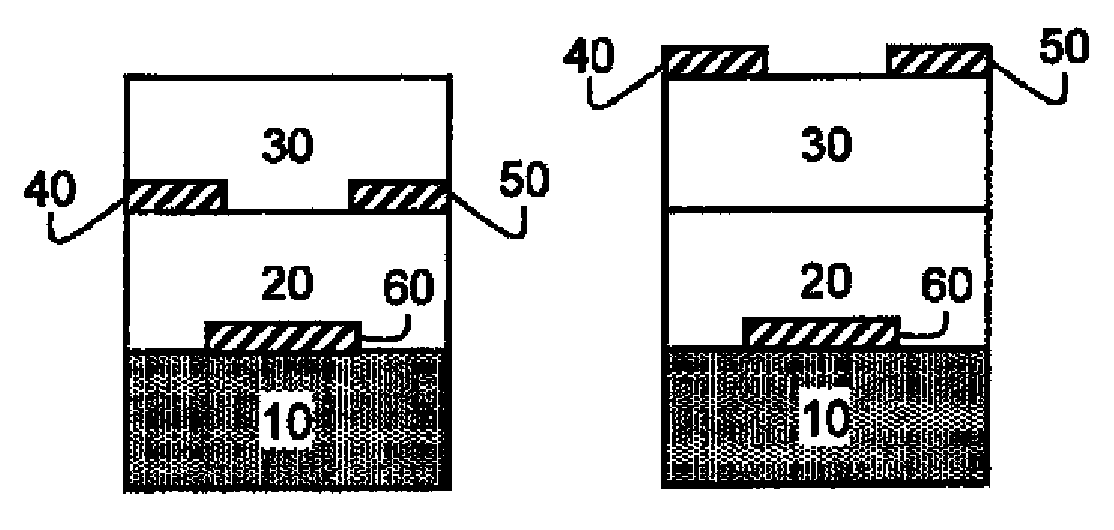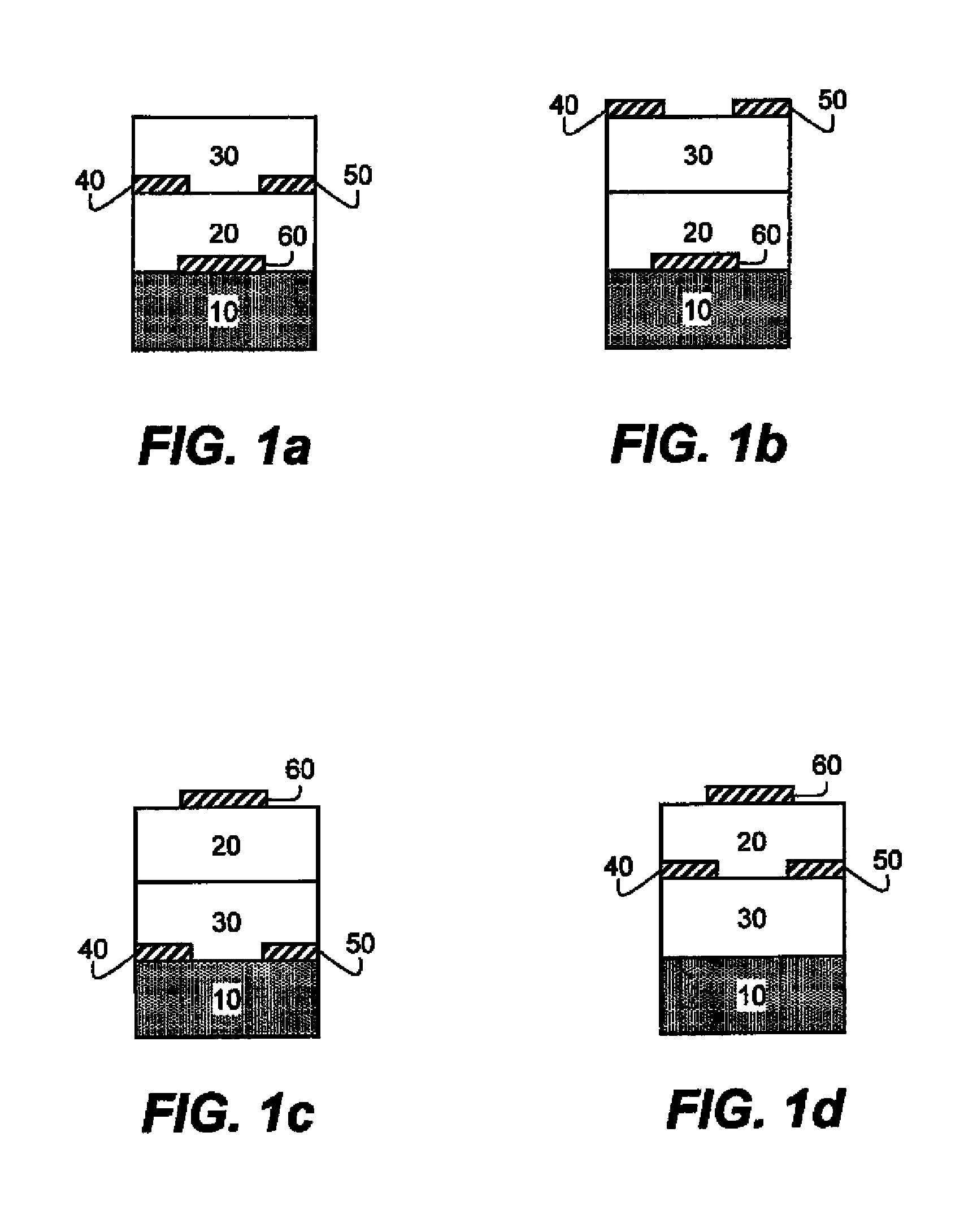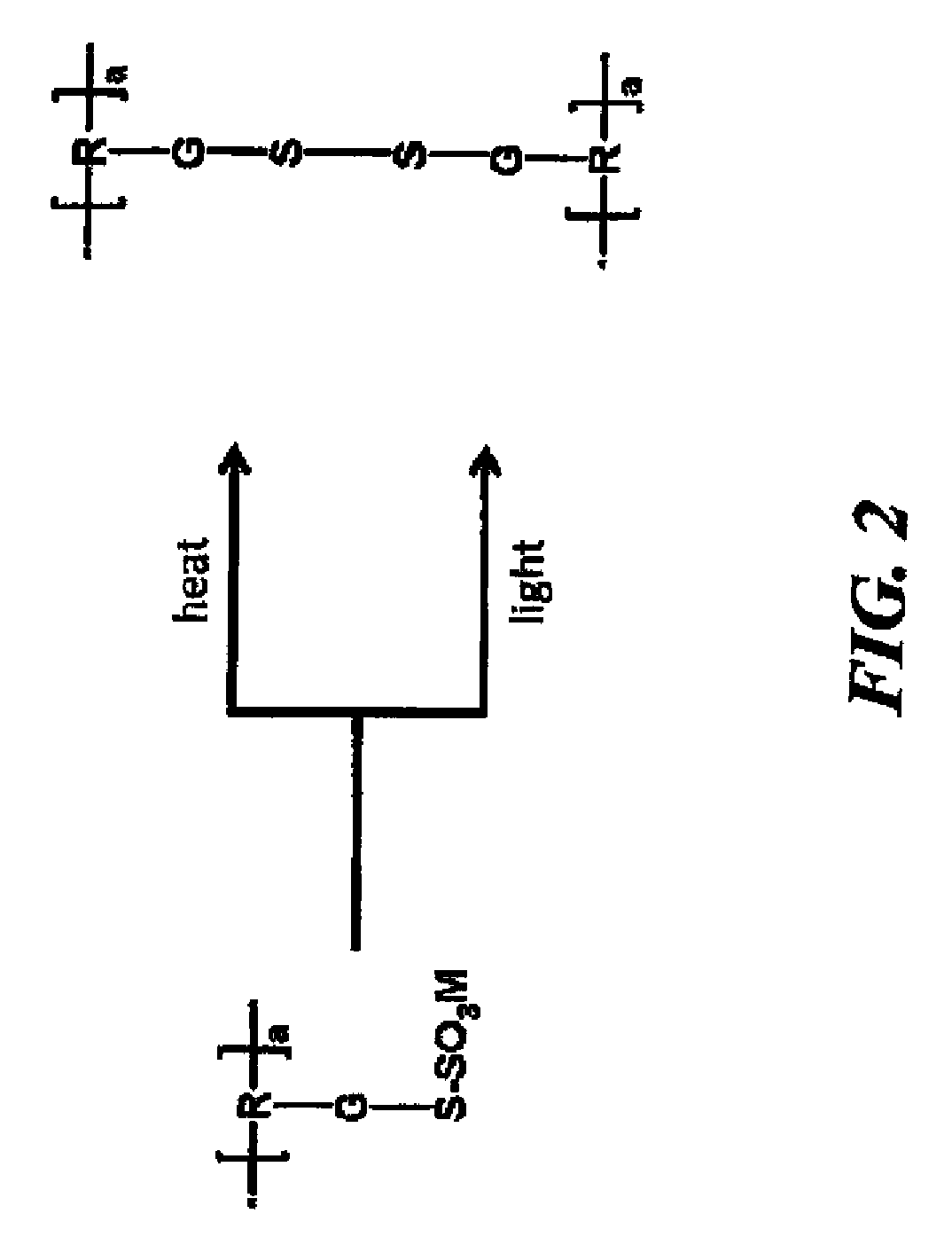Photocurable and thermally curable thiosulfate-containing polymers
a technology of thiosulfate and polymer, which is applied in the field of unique photocurable and thermally curable thiosulfate-containing polymers, can solve the problems of amorphous silicon, limited application of amorphous silicon to low speed devices, and amorphous silicon still has its drawbacks, so as to improve the properties of organic film-forming polymeric precursor dielectric materials, improve the effect of organic field effect transistors and easy manufacturing
- Summary
- Abstract
- Description
- Claims
- Application Information
AI Technical Summary
Benefits of technology
Problems solved by technology
Method used
Image
Examples
##ventive example 1
Inventive Example 1
Preparation of Poly(vinyl benzyl thiosulfate sodium salt-co-methyl methacrylate-co-N-butyl-N′-[2-(ethoxy-2-acrylate)ethyl]-1,4,5,8-naphthalenetetracarboxylic diimide)
[0224]The procedure of Synthesis 1 was followed using vinyl benzyl chloride (4.2 g, 0.027 mol), methyl methacrylate (8.5 g, 0.085 mol), 1,8-naphthalimidohexanol (1.1 g, 0.002 mol), 2,2′-azobis(2-methylbutyronitrile) (0.33 g, 0.002 mol), and 47 ml of toluene. The reaction temperature was 70° C. 1H NMR analysis indicated that the resulting precursor polymer contained 30 mol % of recurring units derived from vinyl benzyl chloride. Analysis by size exclusion chromatography (SEC) indicated a weight average molar mass of 17,800 (polystyrene standards).
[0225]The desired photocurable or thermally curable thiosulfate-containing polymer was prepared as described in Synthesis 1 using 1.35 g of the precursor polymer, 50 ml of DMF, 1.5 g of sodium thiosulfate, and 10 ml of water. The temperature of the reaction so...
##ventive example 2
Inventive Example 2
Preparation of Poly(vinyl benzyl thiosulfate sodium salt-co-methyl methacrylate-co-acrylic acid-co-N-butyl-N′-[2-(ethoxy-2-acrylate)ethyl]-1,4,5,8-naphthalenetetracarboxylic diimide)
[0226]The procedure of Synthesis 1 was followed using vinyl benzyl chloride (8.2 g, 0.053 mol), methyl methacrylate (8.5 g, 0.085 mol), acrylic acid (8.5 g, 0.119 mol), 1,8-naphthalimidohexanol (2.3 g, 0.005 mol), 2,2′-azobis(2-methylbutyronitrile) (0.76 g, 0.004 mol), and 90 ml of dioxane. The reaction temperature was 70° C. 1H NMR analysis indicated that the resulting precursor polymer contained 30 mol % of recurring units derived from vinyl benzyl chloride. Analysis by size exclusion chromatography (SEC) indicated a weight average molar mass of 41,600 (polystyrene standards).
[0227]The desired photocurable or thermally-curable thiosulfate-containing polymer was prepared as described in Synthesis 1 using 26.1 g of the precursor polymer, 285 ml of DMF, 8.5 g sodium thiosulfate, and 57 ...
##ventive example 3
Inventive Example 3
Preparation of Poly(vinyl benzyl thiosulfate sodium salt-co-acrylic acid-co-N-butyl-N′-[2-(ethoxy-2-acrylate)ethyl]-1,4,5,8-naphthalenetetracarboxylic diimide)
[0228]The procedure of Synthesis 1 was followed using vinyl benzyl chloride (7.3 g, 0.048 mol), acrylic acid (15.0 g, 0.21 mol), 1,8-naphthalimidohexanol (1.9 g, 0.005 mol), 2,2′-azobis(2-methylbutyronitrile) (0.76 g, 0.004 mol), and 73 ml of dioxane. The reaction temperature was 70° C. 1H NMR analysis indicated that the resulting precursor polymer contained 31 mol % of recurring units derived from vinyl benzyl chloride. Analysis by size exclusion chromatography (SEC) indicated a weight average molar mass of 21,400 (polystyrene standards).
[0229]The desired photocurable or thermally-curable thiosulfate-containing polymer was prepared as described in Synthesis 1 using 20.0 g of the precursor polymer, 250 ml of DMF, 6.5 g sodium thiosulfate, and 50 ml of water. The reaction temperature was 90° C. for 8 hours to...
PUM
| Property | Measurement | Unit |
|---|---|---|
| Tg | aaaaa | aaaaa |
| temperatures | aaaaa | aaaaa |
| temperature | aaaaa | aaaaa |
Abstract
Description
Claims
Application Information
 Login to View More
Login to View More - R&D
- Intellectual Property
- Life Sciences
- Materials
- Tech Scout
- Unparalleled Data Quality
- Higher Quality Content
- 60% Fewer Hallucinations
Browse by: Latest US Patents, China's latest patents, Technical Efficacy Thesaurus, Application Domain, Technology Topic, Popular Technical Reports.
© 2025 PatSnap. All rights reserved.Legal|Privacy policy|Modern Slavery Act Transparency Statement|Sitemap|About US| Contact US: help@patsnap.com



